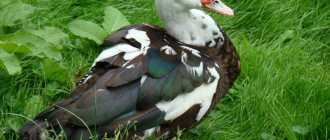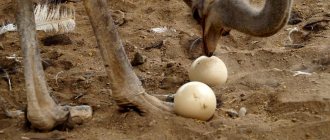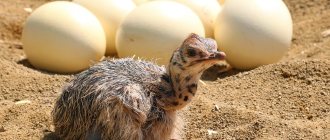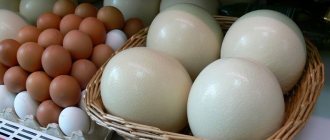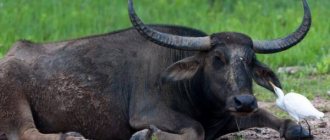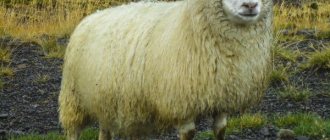The largest land bird is the ostrich. It lives in Africa, in savannah and semi-desert areas. The ostrich is a herbivorous bird, but can eat small fish, insects, and small lizards. Its height reaches 2.7 m, the weight of the Somali subspecies is 170 kg. Emus are not as big as ostriches. They live in Australia and are also herbivores.
They eat grass, shoots of bushes, and often attack the wheat fields of peasants. Emus love water and can swim. While in a river or lake, they catch fish and crustaceans. The bird's height is 1.5 m. Average weight is 50-80 kilograms. How much weight can an ostrich and emu reach in a farm environment?
Ostrich weight table depending on breed
To get an idea of the body weight of a bird, you need to familiarize yourself with the physiological characteristics of several of the most popular species.
| Name | Habitat | Height, weight of adults |
| African - representatives are distinguished by strength and endurance, live 60-70 years | Distributed in Africa and the Middle East | · Malay – 2.1-2.3 m, 145 kg; · Somali – 2.5 m, 105-125 kg; · Massai – 2.1-2.7 m, 130-175 kg; |
| Emu - individuals run at a speed of 50 km/h (stride length - up to 275 cm), live 10-20 years | Australia | parameters: 150-190 cm, 30-55 kg |
| Rheas run at speeds of up to 60 km/h | South America | 130-140 cm, 25-30 kg |
The African black species is mainly bred on farms. With good care and a nutritious diet, females grow up to 2 m and gain weight of 115-120 kg. Males, with a height of 2.5-2.7 m, gain weight of 150-165 kg.
Big moa
Moas, ancient relatives of the ostrich, are no longer found. But they lived on Earth relatively recently. Their homeland is New Zealand. They were divided into three families, represented by 9 species.
The largest - the large moa - reached a height of more than 3.5 m and weighed 250 kg. They are surprising in that they did not have wings or even rudiments. They laid huge eggs weighing 7 kg.
Moa became extinct in the 16th century. But there were rumors that these representatives of the fauna were seen much later - at the beginning of the 19th century. However, the information was not confirmed.
Reference. People in ancient times were no less cruel to the animal world than modern earthlings. Thus, when people appeared on the island, there were about 40 thousand individuals of large moas.
In 1986, in the homeland of the ancient giants, researchers found the paw of a huge bird that looked quite fresh. At first it even seemed that its owner had died relatively recently. But when the remains were examined, it turned out that it was the mummified leg of a large moa.
Weight and dimensions of an ostrich egg
Females lay eggs approximately once every two days. Egg weight ranges from 1.5-2 kg. The recorded maximum weighing result is 2.4 kg. During the year, the ostrich lays 40-80 eggs (each 15-20 cm in size). The egg production period occurs in autumn-winter. Females begin to lay eggs at the age of two (this indicator depends on the species and habitat). A female emu can lay her first egg at the age of 40 months, and a female rhea at the age of 30 months.
Expert opinion
Zarechny Maxim Valerievich
Agronomist with 12 years of experience. Our best country expert.
Ask a Question
It is noteworthy that the color of the shell is combined with the shade of the plumage and differs among different species: female rheas lay yellow eggs, and emus lay green eggs.
Egg production depends on diet and living conditions. The ostrich is an “impressionable” bird, so stressful situations (moving or relocating to other premises) are allowed in a minimal amount.
What do all breeds have in common?
Despite the fact that all breeds of this bird weigh differently, they are united by a number of common details:
- The eggs of this bird are truly the largest on the planet . Even in the smallest breed, one scrambled egg is equal to at least 25 chicken eggs. Eggs of all breeds can not only be eaten - they have an excellent taste and a high content of useful and nutritious substances.
- Ostriches cannot fly, but their wingspan reaches two meters. Wings are used during fights between birds, during courtship dances, or to protect chicks. By the way, birds never hide their heads in the sand - this is a myth. When in danger, birds accelerate to speeds of 50-100 kilometers per hour, depending on the breed and age.
- Most predators in the savannah are afraid of ostriches, since an adult bird can break the skull of even a lion with a kick.
- When there is a lack of food in the wild, birds feed on locusts, although this negatively affects their maximum running speed, and when there is a lack of water, they can even drink salt water.
Kinds
The modern classification identifies three subspecies of Australian inhabitants:
- Woodward, living in the north of the mainland. Color pale gray;
- Rothschild, living in the southwestern region of Australia. Color dark brown;
- new Dutch ostriches living in the south-eastern part. The plumage is gray-black.
The ongoing confusion between emus and African ostriches continues due to superficial similarities. There are fundamental differences between them:
- in the length of the neck - the ostrich is half a meter longer;
- in the anatomical structure of the paws - emus with three fingers, ostriches with two;
- in the appearance of the eggs - in emu they are smaller and deep blue in color.
African ostrich and emu are different birds in Australia.
Breeding goals
Many farmers are happy to breed ostriches to produce excellent meat, which at one time became a replacement for beef in 2000 in Europe. Every year, more and more countries introduce ostrich meat into the assortment of food stores. Ostrich eggs are also popular; one egg weighs about one and a half kilograms.
Ostrich egg shells are often used in making various souvenirs. Farmers profitably sell ostrich leather for making shoes and accessories. Poultry skin is wear-resistant, water-resistant and has a unique texture. Selling the skin alone can pay for the entire ostrich breeding business.
From one ostrich you can get an average of 10 kilograms of fat, which is used in the manufacture of cosmetic creams, balms, various soaps and medicinal ointments. Ostrich feathers can also be sold on the market, however, their demand is not so great.
Incubation
There are special incubators for ostrich eggs. Eggs are incubated only horizontally. When hatching eggs, it should be taken into account that the relative humidity should be at the level of 32-44%; to maintain such indicators, air dehumidifiers are installed in the incubator. The eggs are heat sensitive and change color to turquoise.
If a farmer plans to breed ostriches for the purpose of selling eggs, then he needs an incubator, otherwise, the birds can be allowed to breed naturally.
Story
The first written mentions are found in the 16th century in the works of European scientists. Already in the 17th century, emus bred on the eastern shores of Australia.
The history of the origin of the name of the bird is unknown. Similar words are found in Arabic and Portuguese, where they are translated as “huge bird.”
Some scientists believe that the ostrich from Australia got its name because of its piercing cry.
The first scientific description was made in 1789 by ornithologist John Latham in his work A Voyage to Botany Bay. Then there were 6 varieties of emu, but almost all of them were destroyed by the indigenous people due to the struggle for food.
Today, three subspecies are conventionally distinguished, differing in the territory of distribution and the appearance of males and females.
Slaughter
How are ostriches slaughtered for meat? - difficult. Compared to a chicken, this bird looks like a dinosaur. And the “dinosaur” needs to be caught, stunned, and only then beheaded.
The individual must trust the owner, otherwise, frightened, it will run away, breaking down the fence boards with its strong legs. For this reason, they are not slaughtered on the farm, permanent habitat and walking areas.
A special room with thick walls is suitable for these purposes. Under no circumstances should you slaughter them in a pen with other birds, otherwise you may make enemies among them. Other birds will lose trust, become frightened and experience severe stress.
In order to behead an ostrich, you will need:
- Hammer;
- Knife;
- Rope;
- Metal hook;
Device with electric current supply (for large farms).
- The first stage is beheading. The most important thing is to hit the head correctly (in the middle) with a hammer to stun it so that the ostrich falls unconscious. For this, equipment with current supply is also used: 250 watts are applied for 6-7 seconds. This device is used on large farms. It can kill up to 7 birds at once.
- Next, after stunning, the bird is beheaded with a sharp knife, after cutting the jugular vein in the neck. The carcass is hung upside down on a hook so that the blood comes out. Opening the main artery near the heart will speed up the removal of blood.
- The second stage is cleaning of feathers. They can also be sold.
- The third stage is skinning. Very carefully, with a sharp knife, remove from the toes up through the thigh, try to remove in one or two flaps, without chopping. If you don’t have the skill to do this, you can turn to experienced breeders for help.
- The last stage is the actual cutting of the carcass. The carcass is quartered or butchered according to the principle of processing chicken. Place in plastic bags. Store refrigerated for up to 5 days, frozen for up to 6 months.
Before realizing your dream of owning an exotic bird, it is advisable to undergo training on a farm; fortunately, many farms now provide training services in the care and maintenance of pets.
It would be a good idea to study specialized literature on your own. The main thing is that you enjoy this activity. You need to have patience and dexterity to make your favorite business also profitable.
